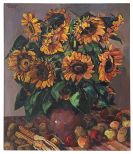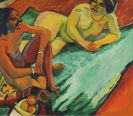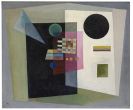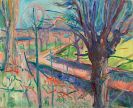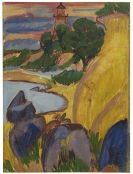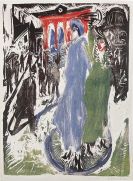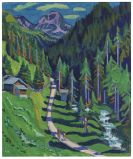
Peter August Böckstiegel
Arrode/Westfalen
1889 -
Arrode/Westfalen
1951
Peter August Böckstiegel was born at Arrode near Werther, a town near Bielefeld, on 7 April 1889. He showed talent at an early age. In 1907 Böckstiegel passed his certificate examinations leading to journeyman status as a painter and glazer in 1907. That same year saw the establishment of a school for crafts and the applied and decorative arts in Bielefeld, where Peter August Böckstiegel studied under Ludwig Godewol until 1913. In winter term 1913 Böckstiegel began to study at the Royal Saxon Academy of Art in Dresden on the recommendation of Max Wrba, whose brother, Georg Wrba, taught at the academy.
In Dresden Böckstiegel met Conrad Felixmüller, whose portrait he painted twice in 1914. Böckstiegel was conscripted into the Saxon Regiment in 1915 but did not share the enthusiasm for the Great War shown by so many of his contemporaries on both sides. While serving in the army, Peter August Böckstiegel had the possibility of working in a studio, where he did numerous Expressive, watercolours in earthy tones. He was delighted to be able to use as models soldiers and children who had been led by curiosity to visit his studio.
Böckstiegel corresponded frequently with Felixmüller, who by then had become active in numerous art projects with political overtones, and Böckstiegel profited from the opportunity thus afforded. His return to Dresden in March 1919 relieved the artist of the nightmarish burden the war had become for him. Böckstiegel joined the group of artists known as "Group 19" but did not remain a member for long since the social aims of the group could not be realised with the Expressionist stylistic repertoire which Böckstiegel employed in his work. The 1920s saw the artist attain maturity in his work while devoting himself to his family.
Peter August Böckstiegel lived in Westphalia during the summer and spent the winters in Dresden. His choice of motifs was by now concentrated on his immediate surroundings. At this time Peter August Böckstiegel also began to approach the working class with his art. Since there was not yet a museum in Bielefeld, the artist transported some of his paintings by handcart to factories, where he explained his work to the workmen.
In 1934 Böckstiegel, too, was forced to become a member of the "Reich Chamber of Culture - Reich Chamber of Fine Art". The National Socialists were ambivalent in their appraisal of Böckstiegel's work; on the one hand, he was not permitted to exhibit in Berlin, on the other, he received quasi official commissions, for which no conditions were made as to style. Peter August Böckstiegel's studio was gutted by the bombing of Dresden in February 1945. After the destruction of the city, Böckstiegel moved to Arrode, where he became the first chairman of the "Westphalian Secession 1945". The first comprehensive retrospective of his work was mounted between June and August 1950 at the Dresden State Art Collections.
Peter August Böckstiegel died at his family home in Arrode on 22 March 1951.
Would you like to sell a work by Peter August Böckstiegel?
Infos for seller
